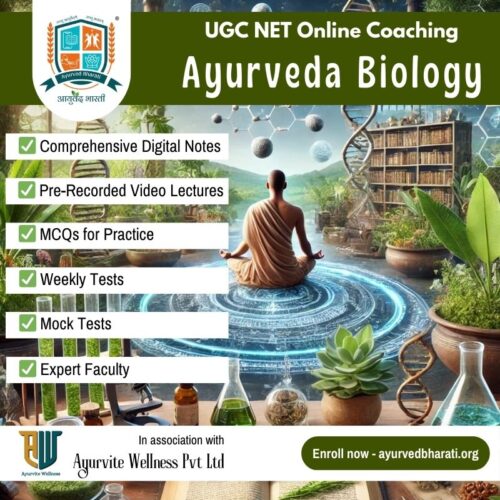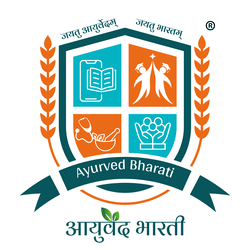Click on curriculum tabs to start learning
Curriculum
- 23 Sections
- 192 Lessons
- 365 Days
Expand all sectionsCollapse all sections
- Unit 1: History and Development of Ayurveda13
- 1.1[VID] Unit 1: History and Development of Ayurveda
- 1.2i. Vedic Origin and Chronological Development of Āyurveda
- 1.3ii. Āyurveda and various schools
- 1.4iii. Understanding and relevance of aṣṭāṅga āyurveda
- 1.5iv. Basic Texts and commentaries of Āyurveda
- 1.6v. Contribution of commentators to Āyurveda
- 1.7vi. Introduction to bṛhattrayī and its importance
- 1.8vii. Introduction to laghutrayī and its importance
- 1.9viii. Basic understanding of nighaṇṭu and kośa of Āyurveda
- 1.10ix. Contribution of contemporary publications in Āyurveda
- 1.11x. Government initiatives for development of Āyurveda
- 1.12Unit – 1 MCQs Set – 1
- 1.13Unit 1 MCQ Set – 2
- Unit 2: Philosophy and Fundamental Principles of Ayurveda12
- 2.1[VID] Unit 2. Philosophy and Fundamental Principles of Ayurveda
- 2.2i. āyu – lakṣaṇa, paryāya, paribhāṣā and pramāṇa
- 2.3ii. Definitions of śarīra, jñānendriya, karmendriya, mana, buddhi, citta, ahaṃkāra, ātmā
- 2.4iii. puruṣa
- 2.5iv. Definitions of Ayurveda
- 2.6v. svāsthya lakṣaṇa
- 2.7vi. paṃcamahābhūta
- 2.8vii. Theories of sāmānya and viśeṣa
- 2.9viii. padārtha
- 2.10ix. doṣa – śarīrika and mānasika
- 2.11x. Introduction to dhātu, mala, agni and srotas
- 2.12Unit – 2 MCQ Set – 1
- Unit 3: Sharira Rachna and Kriya12
- 3.1[VID] Unit 3: Sharira Rachna and Kriya
- 3.2i. Introduction to śarīra racanā kriyā
- 3.3ii. garbhaśarīra (fetal development)
- 3.4iii. Introduction to śarīra pramāṇa
- 3.5iv. Introduction to deha prakṛti and mānasa prakṛti
- 3.6v. Introduction to doṣa, sapta dhātu and mala vijñāna
- 3.7vi. Definition and types of – asthi, sandhi, snāyu, peśī, parva and kaṇḍarā
- 3.8vii. Definition, types and numbers of srotas, dhamanī, śirā and nāḍī
- 3.9viii. ojas and its importance
- 3.10ix. Definition of agni and types – jaṭharāgni, dhātvāgni and bhūtāgni
- 3.11x. marma – Definition and types
- 3.12Unit 3 MCQs Set 1
- Unit 4: Padartha Vijnana and Dravya Vijnana12
- 4.1[VID] Unit 4: Padartha Vijnana and Dravya Vijnana
- 4.2i. padārtha – Definition and types – saptapadārtha
- 4.3ii. Definition and types of pramā, prameya, pramātā, pramāṇa and pramāṇa catuṣṭaya
- 4.4iii. pramāṇa
- 4.5iv. Origin of dravya, Definition and types – kāraṇa and kārya dravya
- 4.6v. auṣadha and āhāra dravya, āyuṣya – anāyuṣya dravya
- 4.7vi. Basic concept of rasa pañcaka
- 4.8vii. dravya – nāma-rūpa-guṇa-karma-yoga-prayoga-saṃyoga vijñāna
- 4.9viii. Basic concept, classification, and application guṇa, vīrya and vipāka
- 4.10ix. Basic concept of karma and its classification
- 4.11x. dravya in accordance with karma and its uses in health and disease
- 4.12Unit 4 MCQs Set 1
- Unit 5.1. Rasa Shastra and bhaiṣajya Kalpana11
- 5.1[VID] Unit 5.1. Rasa Shastra and bhaiṣajya Kalpana
- 5.2i. Origin and Development of rasa śāstra and bhaiṣajya kalpanā
- 5.3ii. rasa – Definition, Types of rasa śodhana prakāra and saṃskāra
- 5.4iii. uparasa sādhāraṇa rasa, ratna, and uparatna
- 5.5iv. Principles of auṣadha nirmāṇa, jāraṇa, māraṇa, satvapātana, nirvāpa and āvāpa
- 5.6v. Basic concept of bhaiṣajya kalpanā
- 5.7vi. rasaśālā, Good Collection Practices and Good Manufacturing Practices
- 5.8vii. Basic Pharmaceutical dosage forms and Secondary dosage forms of āyurveda
- 5.9viii. Definition of puṭa, its types and use in various pharmaceutical forms
- 5.10ix. auṣadha sevana kāla and auṣadha sevana mārga
- 5.11Unit 5.1. MCQs Set 1
- Unit 5.2. Pharmacopoeia8
- 6.1[VID] Unit 5.2. Pharmacopoeia
- 6.2i. Āyurvedic Pharmacopoeia of India (API)
- 6.3ii. Āyurvedic Formulary of India (AFI)
- 6.4iii. Drugs and Cosmetics Act
- 6.5iv. Extra-pharmacopoeial drugs (Anukta dravya)
- 6.6v. Knowledge of pharmaco-vigilance in Āyurveda
- 6.7vi. Pharmacogenomics of active compounds of Āyurveda and multi-omics approach
- 6.8Unit 5.2. MCQs Set 1
- Unit 6.1. Disease Biology10
- 7.1[VID] Unit 6.1. Disease Biology
- 7.2i. Definition of disease, Etiology and Pathology
- 7.3ii. Congenital and Acquired diseases
- 7.4iii. Communicable and Non-communicable diseases
- 7.5iv. Genetic and Epigenetic factors in health and diseases
- 7.6v. Autoimmune diseases and Lifestyle disorders
- 7.7vi. Deficiency and Metabolic diseases
- 7.8vii. Psychological disorders
- 7.9viii. Benign tumors and various types of cancers
- 7.10Unit 6.1. MCQs Set 1
- Unit 6.2. Microbiology9
- 8.1[VID] Unit 6.2. Microbiology
- 8.2i. Historical perspectives of Microbiology, Immunization, Epidemics and Pandemics
- 8.3ii. Antimicrobial resistance, Immune response by microorganisms, Sterilization and disinfection
- 8.4iii. Microbial Diversity and Physiology
- 8.5iv. Gut-Brain axis (GBA) and Microbiome
- 8.6v. Microorganisms’ isolation and characterization, culture media
- 8.7vi. Environmental microflora, Bio-remediation, Dairy microbiology, Indicator organisms and tests and water borne diseases
- 8.8vii. Genetic Recombination, Transformation, Conjugation and Transduction
- 8.9Unit 6.2. MCQs Set 1
- Unit 6.3. Immunology9
- 9.1[VID] Unit 6.3. Immunology
- 9.2i. Role of RBCs, WBCs, platelets and plasma proteins in immune mechanisms
- 9.3ii. Biophysics of Immune System
- 9.4iii. Antigen antibody reactions
- 9.5iv. Natural and Acquired immunity, cell-mediated immunity and toxicity and cytokines
- 9.6v. Immunopathology and autoimmune diseases
- 9.7vi. Antibody isolation and purification, ELISA etc.
- 9.8vii. History of vaccines, attenuated vaccine etc.
- 9.9Unit 6.3. MCQs Set 1
- Unit 7.1. Genetics and Ayurgenomics8
- 10.1[VID] Unit 7.1. Genetics and Ayurgenomics
- 10.2i. Principles of Inheritance and Variation, Historical Perspectives of Genetics
- 10.3ii. Human genome and its evolution
- 10.4iii. Exploring genotype to phenotype correlation etc.
- 10.5iv. Basics of human genomics…
- 10.6v. Population genomics, Disease genomics, Pharmaco-genomics, Nutrigenomics
- 10.7vi. P4 and P5 (Predictive, Preventive, Personalized, Participatory and Promotive) medicinal aspects of Āyurveda
- 10.8Unit 7.1. MCQs Set 1
- Unit 7.2. Cell and Molecular Biology10
- 11.1[VID] Unit 7.2. Cell and Molecular Biology
- 11.2i. Plant and animal cells – Structure and Function
- 11.3ii. Early evidences and Experiments of DNA
- 11.4iii. Watson-Crick model, DNA, RNAs, gene and genome, prokaryotes and eukaryotic genes, C-value paradox
- 11.5iv. DNA replication-conservative…
- 11.6v. Types of gene mutations
- 11.7vi. Gene expression and regulation in prokaryotes
- 11.8vii. Mechanism of Gene Transcription and Translation
- 11.9viii. Basic concepts of Genetic Engineering and Biotechnology
- 11.10Unit 7.2. MCQs Set 1
- Unit 8.1. Physiology8
- Unit 8.2. Biochemistry7
- 13.1i. Concept of atoms and molecules
- 13.2ii. Carbohydrate chemistry and metabolism…
- 13.3iii. Lipid chemistry and metabolism…
- 13.4iv. Chemistry and metabolism of Proteins and Amino acids…
- 13.5v. Heme synthesis and disorders
- 13.6vi. Structure, function and metabolisms of nucleic acids, DNA and RNA
- 13.7Unit 8.2. MCQs Set 1
- Unit 8.3. Nanotechnology6
- Unit 9.1. Biodiversity and Environmental Health7
- 15.1i. Biodiversity of Medicinal plants and animals
- 15.2ii. Pharmacological properties of secondary and active metabolites of medicinal plants
- 15.3iii. Concept of ecosystem…
- 15.4iv. Biodiversity and its conservation…
- 15.5v. Renewable and non-renewable biological resources
- 15.6vi. Degradation of biodiversity
- 15.7Unit 9.1. MCQs Set 1
- Unit 9.2. Intellectual Property Rights (IPR)6
- 16.1i. Concept, meaning and types of Intellectual Property (IP)…
- 16.2ii. Protection of Traditional Knowledge System (TKS)…
- 16.3iii. Introduction to the Indian patent office…
- 16.4iv. The role of databases and registers in the legal protection of TKS…
- 16.5v. WTO, TRIPS, WIPO, CBD, FAO, NAGOYA Protocol
- 16.6Unit 9.2. MCQs Set 1
- Unit 9.3. Entrepreneurship7
- 17.1i. Definition of Entrepreneur, Entrepreneurial traits…
- 17.2ii. Opportunities for Entrepreneurs in relation to food and drugs of Ayurveda for wellness
- 17.3iii. Innovations and new ideas in Āyurveda R&D…
- 17.4iv. Entrepreneurship development programs of public and private agencies…
- 17.5v. Laboratory to market…
- 17.6vi. Business preparation…
- 17.7Unit 9.3. MCQs Set 1
- Unit 10.1. Research Methodology8
- 18.1i. Research Methodologies and Bioethics in Āyurveda
- 18.2ii. Fundamental principles-based research in Āyurveda
- 18.3iii. Food and drug-based research in Ayurveda
- 18.4iv. Pre-clinical and Clinical trials
- 18.5v. Various extraction methods of plant materials…
- 18.6vi. Purification of bioactive compounds through various chromatographic methods
- 18.7vii. Identification of Functional Groups in Phytochemicals
- 18.8Unit 10.1 MCQs Set 1
- Unit 10.2. Biostatistics7
- 19.1i. Average, Mean, Mode, Median…
- 19.2ii. Power and sample size calculation and Basic Principles of Statistical Inference…
- 19.3iii. Correlation analysis, Regression analysis and Survival analysis
- 19.4iv. Genome Mapping Statistics and Bioinformatics
- 19.5v. Types of data and its classification…
- 19.6vi. Exploratory data analysis, descriptive statistics and inferential statistics
- 19.7Unit 10.2. MCQs Set 1
- Unit 10.3. Ayurveda-informatics9
- 20.1i. Chronological Development of Āyurvedic drug manufacturing industries
- 20.2ii. Government policies and initiatives for the development of Āyurveda
- 20.3iii. Ordinance, Rules and Regulations in the manufacturing of quality
- 20.4iv. Review of important modern works on classical medicinal plants…
- 20.5v. Important organizations of Ayurveda
- 20.6vi. Research publication portals in Āyurveda and contemporary medical science…
- 20.7vii. Use of modern technology to confirm the various fundamental principles…
- 20.8viii. Health informatics in Āyurveda in present global scenario
- 20.9Unit 10.3. MCQs Set 1
- Previous Year's Solved Question Papers1
- Ayurveda Biology Model Question Papers & Mock Tests2
- General Aptitute (UGC NET Paper -I) Model Question Papers10
- 23.1General Aptitute Model Question Paper 01 (Hindi)
- 23.2General Aptitute Model Question Paper 02 (Hindi)
- 23.3General Aptitute Model Question Paper 03 (Hindi)
- 23.4General Aptitute Model Question Paper 04 (Hindi)
- 23.5General Aptitute Model Question Paper 05 (Hindi)
- 23.6General Aptitute Model Question Paper 01 (English)
- 23.7General Aptitute Model Question Paper 02 (English)
- 23.8General Aptitute Model Question Paper 03 (English)
- 23.9General Aptitute Model Question Paper 04 (English)
- 23.10General Aptitute Model Question Paper 05 (English)
Instructor


